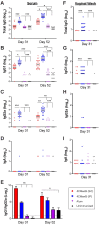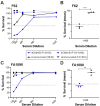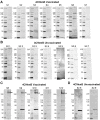The serogroup B meningococcal outer membrane vesicle-based vaccine 4CMenB induces cross-species protection against Neisseria gonorrhoeae
- PMID: 33290434
- PMCID: PMC7748408
- DOI: 10.1371/journal.ppat.1008602
The serogroup B meningococcal outer membrane vesicle-based vaccine 4CMenB induces cross-species protection against Neisseria gonorrhoeae
Abstract
There is a pressing need for a gonorrhea vaccine due to the high disease burden associated with gonococcal infections globally and the rapid evolution of antibiotic resistance in Neisseria gonorrhoeae (Ng). Current gonorrhea vaccine research is in the stages of antigen discovery and the identification of protective immune responses, and no vaccine has been tested in clinical trials in over 30 years. Recently, however, it was reported in a retrospective case-control study that vaccination of humans with a serogroup B Neisseria meningitidis (Nm) outer membrane vesicle (OMV) vaccine (MeNZB) was associated with reduced rates of gonorrhea. Here we directly tested the hypothesis that Nm OMVs induce cross-protection against gonorrhea in a well-characterized female mouse model of Ng genital tract infection. We found that immunization with the licensed Nm OMV-based vaccine 4CMenB (Bexsero) significantly accelerated clearance and reduced the Ng bacterial burden compared to administration of alum or PBS. Serum IgG and vaginal IgA and IgG that cross-reacted with Ng OMVs were induced by 4CMenB vaccination by either the subcutaneous or intraperitoneal routes. Antibodies from vaccinated mice recognized several Ng surface proteins, including PilQ, BamA, MtrE, NHBA (known to be recognized by humans), PorB, and Opa. Immune sera from both mice and humans recognized Ng PilQ and several proteins of similar apparent molecular weight, but MtrE was only recognized by mouse serum. Pooled sera from 4CMenB-immunized mice showed a 4-fold increase in serum bactericidal50 titers against the challenge strain; in contrast, no significant difference in bactericidal activity was detected when sera from 4CMenB-immunized and unimmunized subjects were compared. Our findings directly support epidemiological evidence that Nm OMVs confer cross-species protection against gonorrhea, and implicate several Ng surface antigens as potentially protective targets. Additionally, this study further defines the usefulness of murine infection model as a relevant experimental system for gonorrhea vaccine development.
Conflict of interest statement
The authors have declared that no competing financial interests exist.
Figures










References
-
- Bernstein K, Bowen VB, Kim CR, Counotte MJ, Kirkcaldy RD, Kara E, et al. Re-emerging and newly recognized sexually transmitted infections: Can prior experiences shed light on future identification and control? PLoS Med. 2017;14(12):e1002474 Epub 2017/12/28. 10.1371/journal.pmed.1002474 - DOI - PMC - PubMed
-
- Palafox SKV J S, Tauber, A D, Foster SC. Ophthalmia neonatorum. J Clinic Experiment Ophthalmol. 2011;2(1):1–5. 10.4172/2155-9570.1000119 - DOI
Publication types
MeSH terms
Substances
Grants and funding
LinkOut - more resources
Full Text Sources
Other Literature Sources
Miscellaneous

